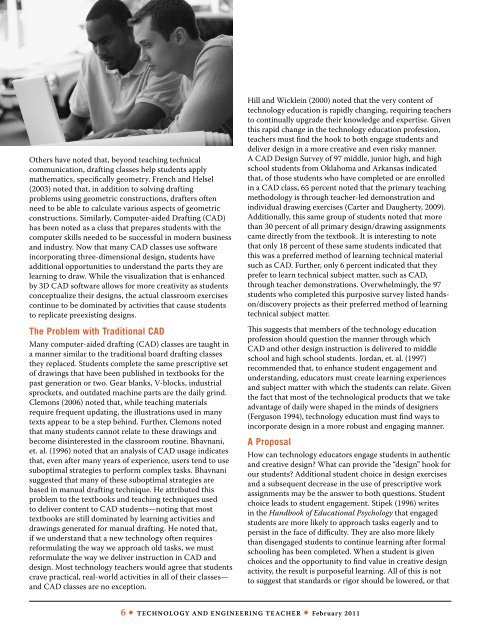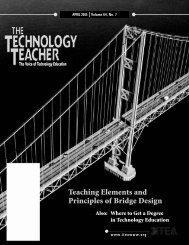K-12 Engineering Education Standards: - International Technology ...
K-12 Engineering Education Standards: - International Technology ...
K-12 Engineering Education Standards: - International Technology ...
Create successful ePaper yourself
Turn your PDF publications into a flip-book with our unique Google optimized e-Paper software.
Others have noted that, beyond teaching technical<br />
communication, drafting classes help students apply<br />
mathematics, specifically geometry. French and Helsel<br />
(2003) noted that, in addition to solving drafting<br />
problems using geometric constructions, drafters often<br />
need to be able to calculate various aspects of geometric<br />
constructions. Similarly, Computer-aided Drafting (CAD)<br />
has been noted as a class that prepares students with the<br />
computer skills needed to be successful in modern business<br />
and industry. Now that many CAD classes use software<br />
incorporating three-dimensional design, students have<br />
additional opportunities to understand the parts they are<br />
learning to draw. While the visualization that is enhanced<br />
by 3D CAD software allows for more creativity as students<br />
conceptualize their designs, the actual classroom exercises<br />
continue to be dominated by activities that cause students<br />
to replicate preexisting designs.<br />
The Problem with Traditional CAD<br />
Many computer-aided drafting (CAD) classes are taught in<br />
a manner similar to the traditional board drafting classes<br />
they replaced. Students complete the same prescriptive set<br />
of drawings that have been published in textbooks for the<br />
past generation or two. Gear blanks, V-blocks, industrial<br />
sprockets, and outdated machine parts are the daily grind.<br />
Clemons (2006) noted that, while teaching materials<br />
require frequent updating, the illustrations used in many<br />
texts appear to be a step behind. Further, Clemons noted<br />
that many students cannot relate to these drawings and<br />
become disinterested in the classroom routine. Bhavnani,<br />
et. al. (1996) noted that an analysis of CAD usage indicates<br />
that, even after many years of experience, users tend to use<br />
suboptimal strategies to perform complex tasks. Bhavnani<br />
suggested that many of these suboptimal strategies are<br />
based in manual drafting technique. He attributed this<br />
problem to the textbooks and teaching techniques used<br />
to deliver content to CAD students—noting that most<br />
textbooks are still dominated by learning activities and<br />
drawings generated for manual drafting. He noted that,<br />
if we understand that a new technology often requires<br />
reformulating the way we approach old tasks, we must<br />
reformulate the way we deliver instruction in CAD and<br />
design. Most technology teachers would agree that students<br />
crave practical, real-world activities in all of their classes—<br />
and CAD classes are no exception.<br />
Hill and Wicklein (2000) noted that the very content of<br />
technology education is rapidly changing, requiring teachers<br />
to continually upgrade their knowledge and expertise. Given<br />
this rapid change in the technology education profession,<br />
teachers must find the hook to both engage students and<br />
deliver design in a more creative and even risky manner.<br />
A CAD Design Survey of 97 middle, junior high, and high<br />
school students from Oklahoma and Arkansas indicated<br />
that, of those students who have completed or are enrolled<br />
in a CAD class, 65 percent noted that the primary teaching<br />
methodology is through teacher-led demonstration and<br />
individual drawing exercises (Carter and Daugherty, 2009).<br />
Additionally, this same group of students noted that more<br />
than 30 percent of all primary design/drawing assignments<br />
came directly from the textbook. It is interesting to note<br />
that only 18 percent of these same students indicated that<br />
this was a preferred method of learning technical material<br />
such as CAD. Further, only 6 percent indicated that they<br />
prefer to learn technical subject matter, such as CAD,<br />
through teacher demonstrations. Overwhelmingly, the 97<br />
students who completed this purposive survey listed handson/discovery<br />
projects as their preferred method of learning<br />
technical subject matter.<br />
This suggests that members of the technology education<br />
profession should question the manner through which<br />
CAD and other design instruction is delivered to middle<br />
school and high school students. Jordan, et. al. (1997)<br />
recommended that, to enhance student engagement and<br />
understanding, educators must create learning experiences<br />
and subject matter with which the students can relate. Given<br />
the fact that most of the technological products that we take<br />
advantage of daily were shaped in the minds of designers<br />
(Ferguson 1994), technology education must find ways to<br />
incorporate design in a more robust and engaging manner.<br />
A Proposal<br />
How can technology educators engage students in authentic<br />
and creative design? What can provide the “design” hook for<br />
our students? Additional student choice in design exercises<br />
and a subsequent decrease in the use of prescriptive work<br />
assignments may be the answer to both questions. Student<br />
choice leads to student engagement. Stipek (1996) writes<br />
in the Handbook of <strong>Education</strong>al Psychology that engaged<br />
students are more likely to approach tasks eagerly and to<br />
persist in the face of difficulty. They are also more likely<br />
than disengaged students to continue learning after formal<br />
schooling has been completed. When a student is given<br />
choices and the opportunity to find value in creative design<br />
activity, the result is purposeful learning. All of this is not<br />
to suggest that standards or rigor should be lowered, or that<br />
6 • <strong>Technology</strong> and <strong>Engineering</strong> Teacher • February 2011
















